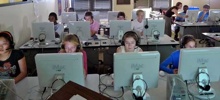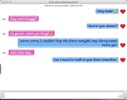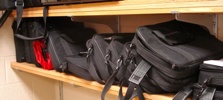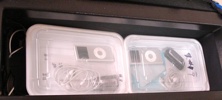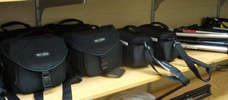Last week I co-hosted an event at Durham Academy sponsored by the North Carolina Association of Independent Schools. The conference theme was on Blended Learning – When Brick and Mortar meets Virtual. We had a great crowd and I believe the day went well. There are many resources on the wiki so take a look.
We gave the participants an iPod Touch loaded with apps and no one asked how to use it? At least no one said, how am I supposed to start using this thing? What I saw was teachers, administrators, board members just sliding the unlock button and start using it. This is different from when we did a panel discussion and the first question was how to start using a blended learning environment. Just start is the best answer.
I sent the list of iTouch apps that Apple had installed to a teacher at the Upper School who has shown, shall I say, a strong desire to use this tool with his AP Physics students. I have written about him before but this is a classic. He took the list of apps and put them on his iTouch. He found many errors so he told the programmer. Here is a transcript of sorts as I have deleted out the name of the application to protect the person who is creating it and too keep my lawyers happy.
Dear Folks, I just purchased ++++++++++ from the Apps Store. I went to the physics section and was, simply put, disappointed and pretty shocked. You have quite a number of errors or over simplifications of concepts that make the formulas simply wrong or misleading.
1. Your formula for force is stated as F=ma. Actually, the formula is Fnet=ma. This is not a trivial point since in any situation where more than one force acts on an object (many, MOST, situations) ma equals the vector sum of all the forces, i.e. Fnet.
2. Your formula for weight states that “g” is “gravity.” This may sound picky, but “g” does NOT stand for gravity (which is a force) but rather the ACCELERATION DUE TO GRAVITY. I believe your statement would be much better if you said “g is the acceleration due to gravity.”
3. Your “formula” for Gravity is stated as g=9.8 m/s. This is incorrect on two fronts. If you want to give the simple formula for the force of gravity it would be Fgravity = mg…not g=9.8 m/s! Also, g (as I stated in #2) stands for the ACCELERATION DUE TO GRAVITY. The acceleration due to gravity at the surface of the earth is 9.8 m/s/s or 9.8 m/s^2. You have the wrong units for g, the acceleration due to gravity! m/s is speed. m/s/s is acceleration. By the way, you will notice that the formula for Weight and the formula for the Force of gravity are the same…mg. This is because, as long as you are not accelerating, such as in an elevator or a roller coaster, the force of gravity down on you will equal the force of a scale up on you so that you do not move. Scales read your weight.
4. Your formula for “Gravitation,” which is Newton’s more complex and general formula for Gravity, is TOTALLY wrong and confusing to boot. You have written it as…”6.67 x 10^-11 Nm^2/kg^2. Newton’s General Formula for the force of Gravitation is: Fgravitation = Gm1m2/r^2 where G is the Universal Gravitational Constant and is equal to 6.67 x 10^-11 Nm^2/kg^2.
So, your formula for Gravitation is actually just the value for G (number and units)! G is just one part of the whole formula used to calculate the force of gravity between two objects, m1 and m2 a distance, r, apart. For example, this formula could be used to find the force of gravity by the sun on the earth.
5. Your “Basic eq’s of Motion” lists 4 formulas on one screen with a very rudimentary explaination-to the point of almost being useless.
I am a physics teacher. (Maybe you guessed that by my comments!) I have encouraged my students to download your app as I thought it would be a nice resource for all the relationships we use in the study of nature through the “prince of sciences”. Your app is significantly deficient in the number of physics formulas it covers and it is very disappointing to see the very poor proof reading that went into those formulas. Just for fun, I have attached a formula sheet I use in my classes for Mechanics. I hope they offer you a glimpse of what your app could do if more time were spent refining it-at least in the physics section.
I’m really not trying to be obnoxious here and I certainly don’t take any delight in telling you about all your mistakes. But, I am now in a situation where my students have a ticking time bomb app on their iphones and itouches. I will correct what you have written for them, but it would be very nice if you repaired these formulas. It would, as a minimum, save you from having to receive harangues from physics “know it alls” like me. 🙂
Sincerely, Louis Parry
This of course leads to a major concern as to whether the applications being written are akin to what wikipedia once was for some folks. Who are the folks writing these applications?
What follows is the response from the creator of the application:
Mr. Parry:
Thank you for sending me these vital corrections.
To begin, I completely understand your frustration and anger – you and your students have paid for an app, and with it should come the most correct information. I apologize for failing to do so. I am, myself, a high school student, and I am constantly refining ++++++++++ for maximum accuracy. Having physics next semester, using any of these “formulas” would land me a lost credit.
All of these inaccuracies will be changed immediately, and will add/remove/correct/change as per your attached PDF. Expect an update within the week (Apple takes around that long to approve app updates.)
Thank you very much for the heads-up: you have gone a long way to improve the app for everyone. Please keep in touch if you would like any additional formulas added or have more comments. I would be delighted to send you some promo codes so more of your students could download +++++++++ free of charge. Just shoot me an email.
B.
Lou just shared with me that he is helping him to understand the formulas. That is how we will teach in the future, no one will know who is the expert but we will all be responsible for fact checking and helping to improve each others work.
Technorati Tags: class2.0, devices, learning
